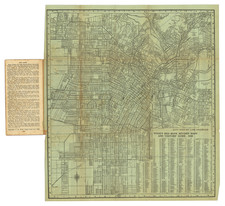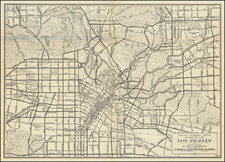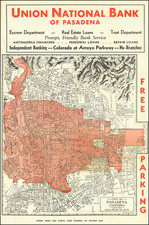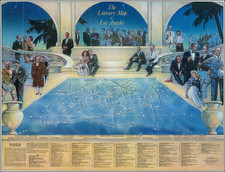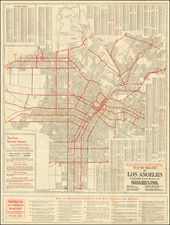Half Way To Venice
Rare separately published map of Culver City, drawn by R.H. Albright.
The map is centered on the "Short Line", the rail line extending from Los Angeles to Venice Beach.
The map promotes the original subdivision of Harry H. Culver, with each street showing specific landscaping designs. A key map locates Culver City and shows in darker blue the sections then being offered for sale.
The name Culver City was first mentioned in the Los Angeles Times on July 27, 1913, at which time it was described as " a city on paper".
The term "The Searchlight City," appeared only once in the Venice Evening Vanguard of April 26, 1915.
Culver City
Harry Culver first attempted to establish Culver City in 1913 and it was officially incorporated on September 20, 1917. His first ads read "All roads lead to Culver City". While this slogan might seem welcoming to all, the city was explicitly founded as a whites-only sundown town, as were most of the suburbs and towns outside the downtown and Central Avenue districts of Los Angeles.
Culver ran ads promoting “this model little white city”, while his close associate, Guy M. Rush, promoted lot sales “restricted to Caucasian race”. The city also at times excluded people of non-Christian religious faiths.
The first film studio in Culver City was built by Thomas Ince in 1918 for The Triangle Motion Picture Company. Silent film comedy producer Hal Roach built his studios there in 1919, and Metro Goldwyn Mayer (MGM) took over the Triangle studio complex in 1924. During Prohibition, speakeasies, and nightclubs such as the Cotton Club lined Washington Boulevard.
Harry Hazel Culver was a real estate developer and promoter.
He was born in Milford, Nebraska, the middle child of five of Jacob H. and Ada L. (Davison) Culver, who lived on a farm. At age 18, he enlisted in the Spanish–American War and served as a corporal and sergeant.
After attending liberal arts college Doane College for a year, Culver studied business at the University of Nebraska for 3 years. From 1901 to about 1904, he worked in the Philippines in the mercantile business and as a reporter for the Manila Times and special customs agent.
He began working in real estate in Southern California in 1910 for Isaac Newton Van Nuys.
In 1913, in a speech at the California Club in Los Angeles, Culver announced his plans for what was to become Culver City. Local voters rejected the land's annexation to LA in 1914, whereupon Culver founded the Culver Investment Company. Supported by a 59-0 vote, Culver City became incorporated on September 20, 1917, with a population of 530.
Once the president of the California Association of Realtors, Culver served as president of the National Association of Realtors in 1923. The following year, he moved his offices to the second floor of Hotel Hunt, now named the Culver Hotel, the building of which he also supported. Culver served locally in elected office and promoted the city with picnics, leading tours with box lunches, and advertising "All Roads Lead to Culver City".
Culver served locally in elected office before his death in Hollywood, California.[citation needed] Advertising Culver City as "See this model little white city, scarcely a year and a half old." (LA Herald March 12, 1915). In 1927 he oversaw the issuing of the following opinion which makes it explicitly clear what he meant. "The Los Angeles Realty Board recommends that Realtors should not sell property to other than Caucasian in territories occupied by them. Deed and Covenant Restrictions probably are the only way that the matter can be controlled; and Realty Boards should be interested. This is the general opinion of all boards in the state."









![[ East Los Angeles / Bristow Park ] New Belvedere Gardens and Union Pacific Industrial Tract](https://storage.googleapis.com/raremaps/img/small/97922.jpg)
